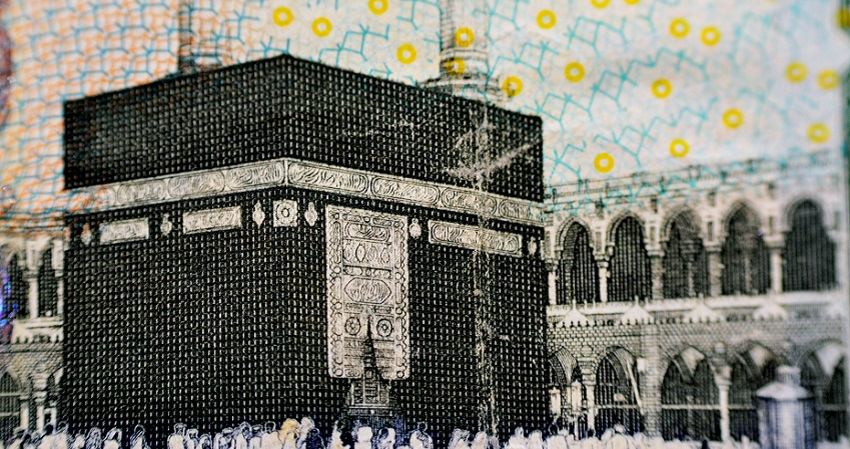The Kaaba is a sacred building situated at the centre of the most prominent mosque in Islam, Masjid al-Haram (Mecca, Saudi Arabia). Renowned for being the most religiously significant shrine amongst Muslims, this square-shaped building is elegantly draped in a cotton and silk veil. Also, referred to as al-Kaʿbah al-Musharrafah, the Kaaba is the final destination for those on the holy pilgrimages of Hajj and Umrah. And, the history of Kaaba can be traced back to pre-Islamic Mecca.
History of Kaaba’s Black Stone

According to the Qur’an, the Kaaba was built by Ibrahim and his son Ismail on Allah’s instructions and it served as the first house of worship for mankind. It is believed that during the construction of the Kaaba, the angel Jibreel brought Ibrahim the Black Stone of Kaaba, which he placed in the Kaaba’s eastern corner. The Black Stone of Kaaba is believed to be one of the original structure’s only remnants built by Ibrahim since the remaining structure was demolished and rebuilt many times for maintenance over the history of Kaaba.
Why is the Kaaba Important?
Kaaba is considered the holiest place on the Earth. There are several verses in the Quran about the revered Kaaba, where it is described as the first house of worship for mankind.
Suggested Read: Inside The Holy Kaaba – The House Of Allah
Once the Kaaba was constructed, Allah urged Ismail’s descendants to perform the annual pilgrimage of Hajj. Also, the area surrounding the shrine was transformed into a sanctuary where violence and bloodshed were forbidden. Originally, the Kaaba was constructed as a simple unroofed structure in a rectangular shape. The Quraysh tribe, which used to rule the pre-Islamic Mecca, rebuilt the Kaaba in 608 CE with wood and masonry blocks.
History of Kaaba: Before & After The Prophet
Before the Prophet: According to many historians, in the days before the rise of Islam, Mecca was a well-known centre of trade and the Kaaba served as a holy site for the various Bedouin tribes all across the Arabian Peninsula. Bedouin people used to go on a pilgrimage to Mecca once a year, where they worshipped their gods in the Kaaba. Statues of various Pagan deities including Hubal were placed in and around the Kaaba.
Kaaba during Prophet Muhammad’s era: During the early phase of the Prophet’s era, the Kaaba was turned into the shrine of Allah, where people belonging to both Pagan and Christian tribes from the Arabian Peninsula visited every year to perform the Hajj pilgrimage. In 628 CE, the Prophet and some of his followers travelled to Mecca to perform Umrah only to be refused entry by the Arab inhabitants of Mecca. Prophet Muhammad managed to secure a peace treaty with them, obtaining permission for the Muslims to perform the pilgrimage at the Kaaba from next year onwards.
In 630 CE, after the inhabitants of Mecca violated the treaty, Prophet Muhammad conquered the holy city. After Muhammad’s victorious return, the Kaaba turned into the focal point of worship and pilgrimage amongst Muslims.
The Late History of Kaaba: After Prophet Muhammad’s death, the Kaaba has been reconstructed several times. In 683 CE, it was severely damaged in a fire during the first siege of Mecca that occurred in the war between Abdullah ibn al-Zubayr and the Umayyads. Abdullah rebuilt the Kaaba to include the Hatīm.
In 692 CE, the second siege of Mecca took place, where the Kaaba was bombarded with stones. The next year, Abd al-Malik razed the remnants of the Kaaba and rebuilt it in a cubical shape, similar to the way it was during the Prophet’s time.
In 1626, there was a flood that resulted in the walls of the Kaaba collapsing. During the same year, the holy mosque was renovated and the Kaaba was rebuilt with granite stones from Mecca. The Kaaba has stayed the same in appearance since then.
Facts about the holy Kaaba
- Initially Kaaba had the two doors that were used to enter and exit the Kaaba respectively. It also has one window in the past.
- In previous days, the holy Kaaba was dubbed in multi colors but with passing time it attained its renowned black color.
- At first Kaaba was open to the general public as well, but as the umrah and hajj started seeing large number of pilgrims, the entry was reserved to only the Muslim dignitaries.
- When a pilgrim is inside in Kaaba, they can pray in any direction as there is no distinction of the correct direction inside the holy Kaaba.
History of Kaaba has many interesting facts and stories that every Muslim should be aware of to know the significance of holy Kaaba.
Suggested Read: Kiswa Of Kaaba – The Holy Cloth That Adorns The House Of Allah
History Of Kaaba FAQs
What is Kaaba?
The Kaaba is a sacred building situated at the centre of the most prominent mosque in Islam, Masjid al-Haram (Makkah, Saudi Arabia). Renowned for being the most religiously significant shrine amongst Muslims, this square-shaped building is elegantly draped in a cotton and silk veil.
What is the history of the Black Stone?
The Black Stone of Kaaba is believed to be one of the original structure only remnants built by Ibrahim since the remaining structure was demolished and rebuilt many times for maintenance over the history of Kaaba.
Why is the Kaaba important?
Once the Kaaba was constructed, Allah urged Ismails descendants to perform the annual pilgrimage of Hajj. Originally, the Kaaba was constructed as a simple unroofed structure in a rectangular shape. The Quraysh tribe, which used to rule the pre-Islamic Makkah, rebuilt the Kaaba in 608 CE with wood and masonry blocks.
What is the history of Kaaba: before & after the Prophet?
According to many historians, in the days before the rise of Islam, Makkah was a well-known centre of trade and the Kaaba served as a holy site for the various Bedouin tribes all across the Arabian Peninsula. Bedouin people used to go on a pilgrimage to Makkah once a year, where they worshipped their gods in the Kaaba. Statues of various Pagan deities including Hubal were placed in and around the Kaaba.
What are the initial structures that can be found in Kaaba?
The holy Kaaba had 2 doors and a window in the initial days.








